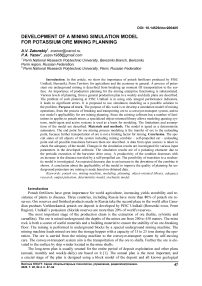Development of a mining simulation model for potassium ore mining planning
Автор: Zatonskiy A.V., Yazev P.A.
Рубрика: Управление в технических системах
Статья в выпуске: 4 т.20, 2020 года.
Бесплатный доступ
Introduction. In this article, we show the importance of potash fertilizers produced by PJSC Uralkali, Berezniki, Perm Territory for agriculture and the economy in general. А process of potassium ore underground mining is described from breaking up moment till transportation to the surface. An importance of production planning for the mining enterprise functioning is substantiated. Various levels of planning, from a general production plan to a weekly and daily plans are described. The problem of such planning at PJSC Uralkali is in using only integral performance indicators, it leads to significant errors. It is proposed to use simulation modeling as a possible solution to the problem. Purpose of work. The purpose of this work is to develop a simulation model of mining operations, from the process of breaking and transporting ore to a conveyor-transport system, and to test model's applicability for ore mining planning. Since the existing software has a number of limitations in applies to potash mines, a specialized object-oriented library allows modeling queuing systems, multi-agent and active systems is used as a basis for modeling. The limitations and assumptions of the model are described. Materials and methods. The model is igned as a deterministic automaton. The end point for ore mining process modeling is the transfer of ore to the unloading point, because further transportation of ore is not a limiting factor for mining. Conclusion. The special states of all objects of the system including mining combine - self-propelled car - unloading point and all possible transitions between them are described. A data from open sources is taken to check the adequacy of the model. Changes in the simulation results are investigated for various input parameters in the developed software. The simulation results are of a pulsating character due to the periodic execution of the harvester drive away. A productivity of the combine decreases with an increase in the distance traveled by a self-propelled car. The possibility of transition to a stochastic model is investigated. An expected decrease due to an increase in the downtime of the combine is shown. A conclusion about the applicability of the model to improve the quality of planning for underground potassium ore mining is made based on obtained data.
Potash ore, mining machine, modeling, planning, object-oriented library, adequacy research, output pulsation, deterministic model, stochastic model
Короткий адрес: https://sciup.org/147233784
IDR: 147233784 | УДК: 622.6 | DOI: 10.14529/ctcr200405
Список литературы Development of a mining simulation model for potassium ore mining planning
- Kaputin Ju.E. Informacionnye tehnologii planirovanija gornyh rabot (dlja gornyh inzhenerov) [Mining planning information technologies (for mining engineers)]. St. Petersburg, Nedra, 2004. 424 p.
- Hustrulid W., Kuchta M. Open Pit Mine Planning and Design. London, Taylor & Francis/ Balkema, 1995.
- Morales N., Seguel S., Caceres A., Jelvez E., Alarcon M. Incorporation of Geometallurgical Attributes and Geological Uncertainty into Long-Term Open-Pit Mine Planning. Minerals, 2019, no. 9 (2), p. 108.
- Matamoro M.E.V., Dimitrakopoulos R. Stochastic Short-Term Mine Production Schedule Accounting for Fleet Allocation, Operational Considerations and Blending Restrictions. European Journal of Operational Research, 2016, vol. 255, pp. 911-921.
- Salama A., Greberg J., Schunnesson H. The Use of Discrete Event Simulation for Underground Haulage Mining Equipment Selection. International Journal of Mining and Mineral Engineering, 2014, vol. 5, no. 3, pp. 256-271.
- Pop-Andonov G., Mirakovski D., Despotov Z. Simulation Modeling and Analyzing in Underground Haulage Systems with Arena Simulation Software. International Virtual Journal for Science, Technics and Innovations for the IndustryMachines, Technologies, Materials, 2012, no. 6, pp. 48-50.
- Solov'ev V.A., Sekuncov A.I. Razrabotka kalijnyh mestorozhdenij: Praktikum [Development of potash deposits: Practicum]. Perm, PNRSTU Publ., 2013. 265 p.
- O'Sullivan D., Newman A. Extraction and backfill scheduling in a complex underground mine. Interfaces, 2014, vol. 44 (2), pp. 204-221.
- Lukichev S., Nagovitsyn O., Belogorodtsev O. Asystemic Approach to Solving the Mining Technology Tasks Based on Modeling its Objects and Processes. Application of Computers and Operations Research in the Mineral Industry Proceedings of the 38th International Symposium, 2017, pp.29-34.
- Chudinov G.V. Opyt razrabotki sistemy imitacionnogo modelirovanija gruzopotoka v kalijnyh rudnikah - PK "Rudopotok" [Experience of Developing a System for Simulation of Cargo Traffic in Potash Mines - PC "Ore Flow"]. Imitacionnoe modelirovanie. Teorija i praktika: Sbornik dokladov pjatoj jubilejnoj vserossijskoj nauchno-prakticheskoj konferencii IMMOD-2011. St. Petersburg, CTSS publ., 2011, vol. 2, pp. 311-315. (in Russ.)
- Zatonskiy A.V., Ufimtseva V.N. [Development of Object Tools for Simulation and Multi-Agent Modeling of Production Processes]. Vestnik Astrahanskogo gosudarstvennogo tehnicheskogo universi-teta. Serija: Upravlenie, vychislitel'naja tehnika i informatika, 2018, no. 4, pp. 56-62. (in Russ.)
- Sobol' A.V., Pinskij V.L. Mehanizacija transportirovanija kalijnyh rud [Mechanization of Transportation of Potash Ores]. Leningrad, Himija Publ., 1973. 160 p.
- Brusilovskij D.V., Sobol' A.V. Mehanizacija provedenija gornyh vyrabotok na kalijnyh rudnikah [Mechanization of Mine Workings in Potash Mines]. Leningrad, Himija Publ., 1973. 156 p.
- Zatonskiy A.V., Varlamova S.A., Malysheva A.V., Mjasnikov A.A. [Use of VideoGraphic Information to Refine the Dynamic Stochastic Model of the Potassium ore Flotation Process]. Internet-zhurnal "Naukovedenie ", 2017, vol. 9, no 2, p. 87. (in Russ.)
- Zatonskiy A.V. Verification of Kolmogorov Equation Usability for Reproduction and Death Processes. Bulletin of the South Ural State University. Ser. Computer Technologies, Automatic Control, Radio Electronics, 2019, vol. 19, no. 3, pp. 60-67. DOI: 10.14529/ctcr190306


